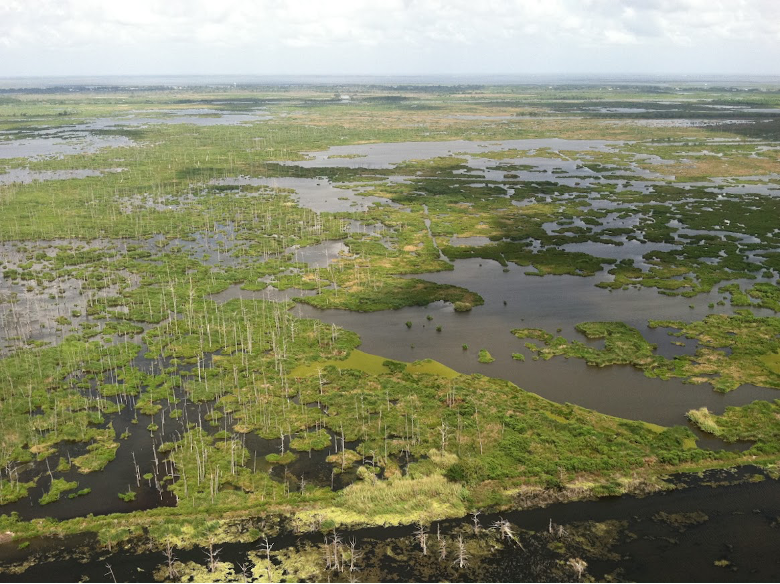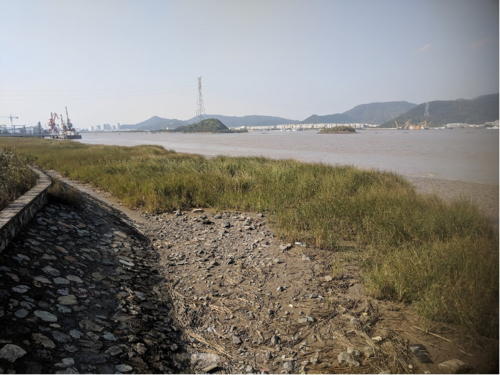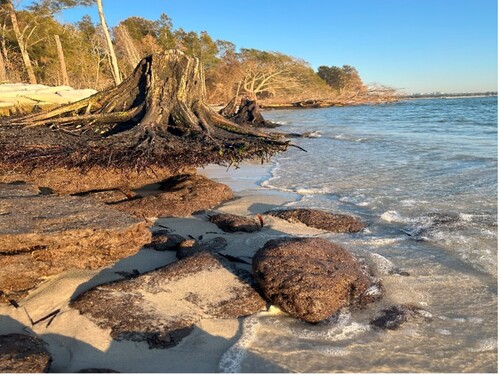01 Sep 2023
Critical Research Underscores the Urgency of Staying Below the 2°C Limit for Safeguarding Coastal Ecosystems

Freshwater swamps in the Mississippi Delta (Louisiana, USA) are being replaced by marsh or open water due to rising sea levels. Image Credit: Nicole Khan, University of Hong Kong
A research study led by Macquarie University, in collaboration with scientists from various institutions worldwide, including Dr Nicole KHAN from the Department of Earth Sciences at HKU, has been published in Nature. The study issues a warning about the potential devastation of coastal habitats due to rising sea levels, drawing on evidence from the last Ice Age.
The research integrates diverse strands of evidence to establish the precise thresholds of coastal wetland resilience in the face of rapid sea-level rise. It also provides crucial estimates regarding the extent to which coastal wetlands will be susceptible to these accelerated rates, considering various warming scenarios that lie ahead.
Ancient Land Connections Expose Ice Age Sea-Level Rise
During the Ice Age, approximately 17,000 years ago, it was possible to walk from Germany to England, Russia to America, and mainland Australia to Tasmania because the sea levels were about 120 meters lower than today. However, as the Ice Age ended, the oceans rose rapidly, averaging one meter per century. This rapid rise in sea levels resulted in the separation of land masses that were previously connected, leading to significant loss of coastal habitat.
The recovery process following the last Ice Age spanned thousands of years. The research conducted by scientists from 17 institutions in Australia, Singapore, Germany, the USA, Hong Kong, and the UK serves as a warning. It highlights that rapid sea-level rise and the retreat of coastal habitats will occur once again if warming levels exceed the targets set by the Paris Agreement. The central aim of the agreement is to strengthen the global response to climate change by ensuring that the global temperature rise this century remains well below 2°C above pre-industrial levels, and to pursue efforts to limit the temperature increase even further to 1.5°C.

Embanked salt marsh in Ningbo, China has nowhere to migrate further inland as sea levels rise in the future.
Image Credit: Nicole Khan, University of Hong Kong.
The study emphasizes the essential role played by mangroves, marshes, coral reefs, and coral islands in protecting coastlines, trapping carbon, nurturing juvenile fish, and sustaining millions of coastal residents.
The report delves into how these coastal habitats retreated and adapted as the last Ice Age ended and how they are likely to cope with the predicted sea-level rises of this century.
Lead author Professor Neil SAINTILAN, a specialist in coastal wetlands from Macquarie University said, ‘Our research shows that these coastal habitats can likely adapt to some degree of rising sea levels, but they will reach a tipping point beyond sea-level rises triggered by more than 1.5 to 2°C of global warming.’
However, without effective mitigation measures, the projected relative sea-level rises under current climate change scenarios will surpass the capacity of coastal habitats like mangroves and tidal marshes to adjust, leading to instability and significant changes in coastal ecosystems.
Mangroves and tidal marshes act as buffers between the ocean and the land, absorbing wave action, preventing erosion, and playing a crucial role in biodiversity and carbon sequestration. These habitats accumulate sediment and slowly move inland, allowing them to adapt to rising sea levels. However, these habitats can struggle to survive when higher sea levels lead to waterlogging, posing a threat to natural mangrove forests and the associated benefits they provide.
Similarly, coral reefs protect coral islands by forming coastal ecosystems that shield the land from the open sea. Beyond 1.5-2°C of global warming, these islands will start disappearing as waves overtop the coral reefs that protect them.
Coastal ecosystems play a significant role in carbon dioxide absorption, climate change mitigation, and protection against ocean storms. However, efforts are required to support and preserve these ecosystems. Subsidence, the gradual sinking of land, further exacerbates the exposure of ecosystems to rising sea levels.
Decoding Past Sea Levels for Future Projections
The study of past sea levels is one of the most important fields of climate science study and is the basis for sea-level projections. The scientists analyzed the conversion of coastal ecosystems to open water and reviewed how they adapted to sea-level rise following the last Ice Age.
Dr Nicole Khan of HKU Department of Earth Sciences specialises in the development and synthesis of records to examine the evolution and driving mechanisms of sea-level fluctuations spanning approximately 20,000 years. Leveraging these records, she delves into unraveling the dynamic responses of coastal wetland ecosystems, including mangroves and tidal marshes, to these historical transformations.
Dr Khan stated, ‘If we can limit warming to 2°C by 2100, only a small percentage of these ecosystems will be exposed to these high rates, but at 3°C and higher, more than 50% of tidal marshes and nearly all mangrove ecosystems will be vulnerable to rapid sea-level rise.’
Dr Khan regards these results as highly alarming. ‘They clearly show the importance of limiting warming to below 2°C to maintain conditions favorable to coastal ecosystem survival and sustain all the benefits these ecosystems provide to us. Our findings should be considered in coastal wetland conservation efforts and nature-based solutions for carbon sequestration (e.g., blue carbon storage) or protection from coastal flooding, both in Hong Kong and globally.
The journal paper, entitled ‘Widespread retreat of coastal habitat is likely at warming levels above 1.5 °C. Nature (2023).’, can be found at the following link: www.nature.com/articles/s41586-023-06448-z
This article is a modified version based on the draft provided by Macquarie University.

Wetland erosion at Towra Point Sydney. Towra Point is a wetland listed as internationally significant under the Ramsar convention.
Sea level rise is one of a number of stressors in this system.
Image Credit: Neil Saintilan







